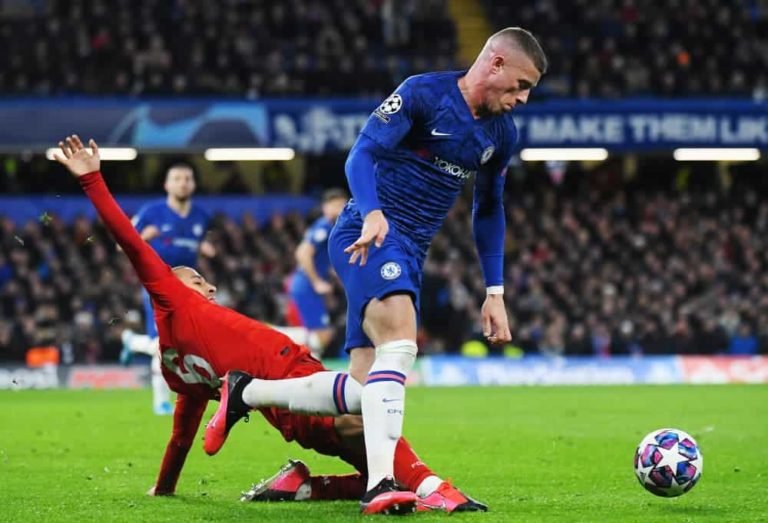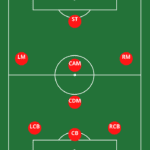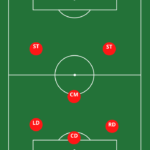- Last Updated -
The Art of the Soccer Tackle
Soccer, also known as football in many countries, is one of the most popular sports in the world. It is a team sport that requires speed, agility, skill, and teamwork. One important aspect of soccer is tackling.
It’s an essential defensive technique that can change the course of a game. In this article, we will discuss what a soccer tackle is and its importance in the game.
What is a Soccer Tackle?
A soccer tackle is a defensive move used to dispossess an opponent player who has control of the ball. It involves getting as close as possible to your opponent and taking possession of the ball or knocking it away from them using your legs or body.
The main objective of tackling in soccer is to win back possession for your team while preventing your opponent from advancing forward.
There are different types of tackles used for different situations such as standing tackles where you use your feet to kick away the ball from an oncoming player, slide tackles which are executed by sliding along with one leg while extending it forward or block tackles where you simply stand in front of an oncoming player so they can’t pass through you.
Importance of Tackling in Soccer
Tackling plays a crucial role in soccer because it provides defenders with an opportunity to stop their opponents from scoring goals or advancing further upfield with possession. A successful tackle can quickly turn defense into offense by providing opportunities for counter-attacks and breakaways. Tackling also requires quick thinking and reflexes, which makes it a challenging technique to master.
Successful tackling requires excellent body control, timing, anticipation skills coupled with flexibility and agility. Tackling plays an essential role in soccer gameplay because it allows defenders to regain possession and stop opponents from scoring goals while providing opportunities for their own team to score.
As such, it’s a valuable skill that requires practice and persistence to master. In the following sections, we’ll delve into different types of tackles, their rules and regulations, techniques for successful tackling among others.

Types of Tackles
Slide Tackle: The Risky Tackle
The slide tackle is one of the most spectacular tackles to watch, but it’s also the most risky. This tackle involves sliding on the ground with one leg extended to knock the ball away from your opponent.
It requires a lot of practice and skill to master this technique without injuring yourself or others. The slide tackle should only be used as a last resort when you have no other option available, such as when your opponent is about to make a breakaway or score a goal.
Timing and accuracy are crucial in this tackle, as mistiming can result in serious injuries or unnecessary fouls. The slide tackle is not recommended for young players or beginners who are still learning basic techniques.
Standing Tackle: The Safe Bet
A standing tackle is a safer alternative to the slide tackle that still allows you to regain possession of the ball without risking injury. This type of tackle involves using your body to block your opponent’s path and knock them off balance while keeping both feet on the ground. You use your arms to push against their upper body while simultaneously taking control of the ball.
The standing tackle can be used in various situations throughout the game, such as when an opposing player is dribbling towards you or when they receive a pass near your team’s goal area. It’s also ideal for younger players who are still developing their skills and don’t want to take unnecessary risks.
Block Tackle: The Aggressive Tackle
The block tackle, also known as shoulder-to-shoulder tackling, is often seen as an aggressive move that can intimidate opponents and win back possession of the ball quickly. This type of tackling involves physically blocking your opponent’s path by using your shoulder or upper body strength against theirs. This type of tackling can be effective when used correctly, but it can also result in fouls and cards if not executed properly.
It’s important to time your tackle accurately and avoid using excessive force while executing the block tackle. This tackle should only be used by experienced players who have mastered the basics of tackling techniques.

Rules and Regulations
The Importance of Knowing the Rules of Tackling in Soccer
Tackling is an essential part of soccer, but it is also one of the most regulated aspects of the game. Without proper knowledge and understanding of the rules and regulations governing tackling, players risk injuring themselves or other players while playing.
Therefore, before you attempt a tackle, it’s important to have a full understanding of the rules. The first rule to know is that tackling must be executed safely and within the parameters established by FIFA.
Players must use their feet to gain possession of the ball from an opponent without making contact with their opponent’s body or legs. Players should avoid lunging into tackles since this can lead to unsafe situations that can cause injuries.
What Constitutes a Foul or Yellow/Red Card Offense?
Fouls are actions that are against the rules, resulting in a free kick being awarded to your opponent. A tackle could be considered a foul if you do not make contact with the ball first or if you use excessive force or aggression when executing your tackle.
Common foul offenses include tripping an opponent, pushing them down using your hands, or using an elbow to knock them over.
If you commit multiple fouls during a match (typically two), you may receive a yellow card warning from officials. A yellow card means that referees have cautioned you for aggressive behavior on one occasion, but if you continue this type of play, they can issue you with another yellow card and send you off with a red card immediately.
Red cards are given out for violent behavior such as maliciously injuring another player or making dangerous tackles that could cause serious harm on purpose. Once issued with this card during a match, players must leave immediately and will miss at least one game as punishment from FIFA authorities.
Knowing how to correctly execute tackles and following the rules surrounding soccer tackles are fundamental to success in the game. By doing so, players can avoid injuring themselves or others and minimize their chances of receiving a yellow or red card from the officials.
Techniques for Successful Tackling
Proper Body Positioning
One of the most important aspects of successful tackling in soccer is proper body positioning. This means getting your body into a low and stable position, with your feet shoulder-width apart and your knees slightly bent.
Your weight should be evenly distributed between both legs, and your arms should be extended out in front of you for balance.
By getting into this position, you’ll be able to quickly change direction and adjust to the movements of the ball carrier. You’ll also be able to generate more power when you make contact with the ball, which can help knock it away from your opponent.
The Importance of Timing and Anticipation
Timing and anticipation are also crucial when it comes to tackling in soccer. You need to be able to read the movements of your opponent and predict where they’re going next in order to make a successful tackle.
This means paying close attention to their body language, keeping an eye on the ball at all times, and being ready to react quickly. It also means knowing when not to tackle – if you’re too far away or if there are other defenders already closing in on the ball carrier, it may be better for you to hold back rather than risk giving away a free kick or penalty.
Tips for Tackling Safely
It’s important to remember that tackling can be a dangerous aspect of soccer if not done properly. To tackle safely, always aim for the ball rather than the player’s legs or body – this will reduce the risk of injury for both yourself and your opponent. You should also try to avoid sliding tackles whenever possible, as these can easily result in fouls or injuries if not executed perfectly.
Instead, focus on standing tackles or block tackles – these are often more effective anyway since they allow you to stay on your feet and quickly recover after making the tackle. By following these tips and mastering the techniques of proper body positioning, timing, and anticipation, you’ll be well on your way to becoming a successful tackler in soccer.
Famous Soccer Tackles
Legendary Tackles That Changed The Course Of Games
Soccer tackles can be game-changers, and some tackles have gone down in history for their sheer impact on the match. One such tackle was made by Roberto Carlos during the 1997 Tournoi de France. In a game against France, with the score tied at 1-1 and only seconds remaining on the clock, Roberto Carlos slid in from behind to stop a French attacking move.
Not only did he take control of the ball, but he also managed to curl it back upfield with incredible precision into the path of Bebeto, who finished off a stunning counter-attack to win the match for Brazil. Another famous tackle that had a massive impact was Terry Butcher’s tackle during a World Cup qualifier against Sweden in 1989.
With England needing at least a draw to qualify for the tournament, Butcher played through most of the match with a head injury that required stitches. However, his brave tackling and defensive skills ultimately saved England from defeat.
The Dirty Tackles That Made Headlines
While soccer tackles are generally an accepted part of play within the rules, some players have made headlines for their overly aggressive or dangerous tackles. One example is Roy Keane’s infamous tackle on Alf-Inge Haaland during a Manchester Derby in 2001.
Keane had been nursing a grudge against Haaland since an incident between them four years earlier when Haaland accused Keane of faking an injury.
During this game, Keane launched himself into Haaland’s knee with full force resulting in a career-ending injury for Haaland. Another dirty tackle that caused controversy was Nigel de Jong’s challenge on Xabi Alonso during Spain vs Netherlands World Cup Final in 2010.
De Jong lunged dangerously at Alonso’s chest, leading with his foot and hitting Alonso high on the chest. The referee did not give a red card, but many people considered it a dangerous play that could have resulted in a serious injury.
The Impact of Tackles on Teams
A well-timed tackle can turn around an entire game for a team. For example, in the 2018 World Cup quarterfinal match between Belgium and Brazil, defender Vincent Kompany made a crucial tackle against Brazilian superstar Neymar Jr. Kompany’s tackle snuffed out Neymar’s dangerous run and helped Belgium secure their place in the semifinals. On the other hand, missed or poorly executed tackles can lead to goals for the opposition.
In the 2006 Champions League Final between Arsenal and Barcelona, Arsenal’s Jens Lehmann was sent off after bringing down Samuel Eto’o with a mistimed tackle outside the box. The resulting free-kick led to Barca scoring their first goal which ultimately led them to victory.
Soccer tackles have played an integral role in shaping some of soccer’s most iconic moments. From game-changing tackles that lead to last-minute goals to controversial ones that ended players’ careers; they demonstrate just how important it is for players to master tackling skills if they hope to succeed at this beautiful game.
Conclusion
What You Need To Know About Soccer Tackles
In this article, we have discussed everything you need to know about soccer tackles. We have covered the different types of tackles, the rules and regulations surrounding tackling in soccer, techniques for successful tackling, and famous soccer tackles. Tackling is an essential skill in soccer.
It helps players regain possession of the ball and stop the opposition from scoring. By mastering different types of tackles and learning when to use them, players can improve their defensive skills and become more effective on the field.
The Importance Of Mastering Tackling Skills For Success In Soccer
To succeed in soccer, it is essential to master tackling skills. Good defenders are critical to a team’s success as they form a solid barrier against the opposition’s attacks.
Effective tackling can also create opportunities for counter-attacks by giving your team possession of the ball. By learning proper body positioning, timing, and anticipation, you can tackle safely without injuring yourself or others.
Remember that tackling is not just about physical strength; it involves mental agility as well. With practice and dedication, anyone can become an excellent tackler in soccer.
Don’t be afraid to make mistakes; they are all part of the learning process. So go out there on the field and start improving your tackling skills today! (1)
FAQs - Soccer Tackle
What is a Soccer Tackle?
- A soccer tackle is a defensive move aimed at dispossessing an opponent of the ball. It involves using legs or body to take possession or knock the ball away, with the primary goal being to win back possession and prevent the opponent from advancing.
What are the Different Types of Soccer Tackles?
- The types include slide tackles, which are risky and involve sliding on the ground; standing tackles, which are safer and involve using the body to block and dispossess; and block tackles, which are aggressive and involve physical blocking.
What are the Rules and Regulations for Tackling in Soccer?
- Tackles must be executed safely, within FIFA’s guidelines, using feet to gain possession without contacting the opponent’s body. Fouls during tackles can lead to penalties, and repeated offenses may result in yellow or red cards.
How to Successfully Execute a Soccer Tackle?
- Successful tackling requires proper body positioning, timing, anticipation, and focusing on the ball rather than the player. Avoiding sliding tackles is advisable for safety.
What is the Impact of Tackles in Soccer Games?
- Tackles can significantly impact games, either positively by changing the course of play or negatively by causing injuries or penalties. They have been crucial in some famous soccer moments.
Introduction: Demystifying a Controversial Issue Soccer is a sport that requires specific...
Read More



















